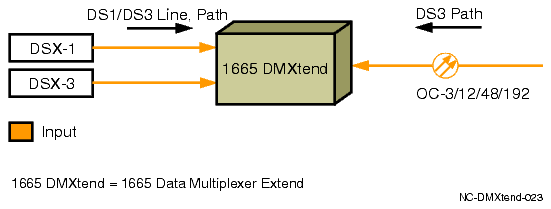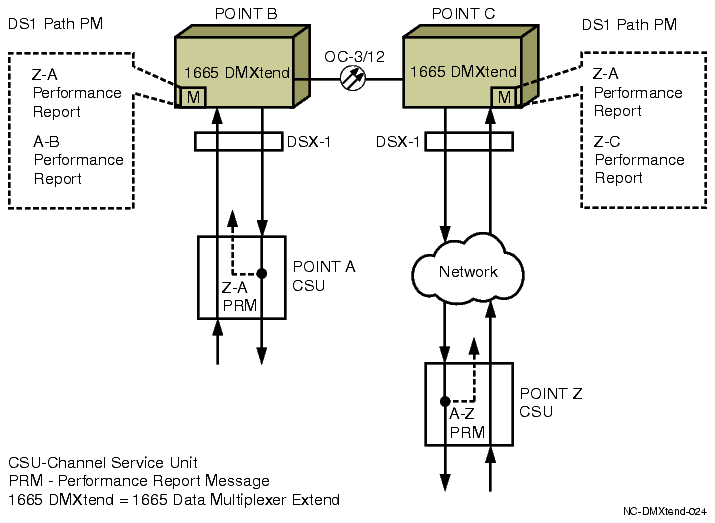Performance monitoring terms
Overview
Alcatel-Lucent 1665 DMXtend uses performance monitoring (PM) to support proactive maintenance of the network and tariffed service performance verification. Proactive maintenance refers to the process of detecting degrading conditions not severe enough to initiate protection switching or alarming but indicative of an impending hard or soft failure. Hard and soft failures result in reactive maintenance. PM conditions are reported on both SONET and electrical interfaces.
Proactive maintenance
Proactive maintenance consists of monitoring performance parameters associated with the SONET sections, lines and paths within the SONET network, as well as incoming and outgoing bytes and frames on electrical (DS1/3) ports. The Standard SONET PM MIB module section, lists the SONET performance parameters monitored by Alcatel-Lucent 1665 DMXtend. Thresholds are set for these parameters to identity degraded performance. When a performance-monitoring threshold is crossed, it is reported to the message-based operations system where all threshold crossings associated with a particular path can be correlated, and the likely source of the degradation can be identified. Electrical performance monitoring parameters are listed later in this section.
The figure below shows DS1/DS3 line and path and DS3 path performance monitoring. Alcatel-Lucent 1665 DMXtend monitors DS3 line and path parameters from the DSX-3 and DS3 path parameters from the optical path.
Figure 5-14: DS1/DS3 line/path performance monitoring

Section parameter
No Far-End PM parameters are defined for the Section layer. The system, as it receives SONET signals, terminates the SONET Section and Line layers and therefore is involved with Section layer PM. Section layer PM applies to optical and electrical SONET interfaces. It also applies to service and protection sections of optical sections.
Line parameter
A line is a physical transport vehicle that provides the means of moving digital information between two points in a network. The line is characterized by a metallic transmission medium and its specific coding type. A line is bounded by its two end points, known as line terminations. A line termination is the point where the electrical, bipolar line signal is generated and transmitted, or received and decoded.
Path parameter
A path is a framed digital stream between two points in a network and represents digital signal transport at a specified rate, independent of the equipment and media providing the physical means of transporting the signal. A path is defined by its two end points, called path terminations, where its frame structure is generated and decoded. A path may be carried wholly within one transport segment (line), or it may span a sequential arrangement of two or more transport segments.
Optical transmission section (OTS) parameter
The OTS layer is the lowest layer of the optical layer network (OLN)/optical transport network (OTN) that provides physical transport of the optical multiplex section (OMS) layer signal via the optical terminal multiplexer (OTM). The OTS layer is terminated on the OTS terminating equipment. The OTS layer represents the server layer for the OMS layer. The OTS layer is comparable in function to the SONET section layer.
Optical channel layer (OCH) parameter
The OCH layer is the top layer of the OLN that provides transport of client signals (e.g., SONET, GbE, OTUk). The OCH layer is terminated on an OCH terminating equipment. The OCH is the information structure used to support the OCH trail. The OCH layer represents the client layer for the OMS layer. The OCH layer is comparable in function to the SONET path layer. The OCH is an information structure consisting of the information payload with a certain bandwidth and non-associated overhead for management of the optical channel.
The LNW785 has 8 OCH ports, supporting ITU-T DWDM channels 52 through 59 (195.20–195.90 THz).
DS1 performance monitoring
Tariffed service verification consists of monitoring performance parameters that can be associated with the customer's end-to-end service. Alcatel-Lucent 1665 DMXtend provides this capability for DS1 services with the DS1 performance monitoring feature. Based on ANSI T1.403 extended superframe format (ESF), this capability retrieves performance messages written into the ESF data link by the customer's terminal equipment. From these messages, Alcatel-Lucent 1665 DMXtend can determine and report the end-to-end error performance of the entire DS1 link as seen by the customer. The parameters, listed in Table 5-8, DS1 performance parameters, are set and reported to indicate degraded performance. The counts are retrieved by the message-based operations system to determine if the service is operating within tariffed limits.
Application of the DS1 performance monitoring feature for tariffed service verification is shown in the figure below. This shows an ANSI T1.403 ESF format DS1 service carried between points A and Z, using an OC-48/OC-192 system and terminated at the customer's premises with channel service units (CSUs). At the "A" end, the received error performance, (Z–A) is detected and written by the customer CSU onto the outgoing (A–Z) ESF data link as a performance report message (PRM). The DS1 PM circuit pack interfacing the A end reads the incoming DS1 signal's PRM (received from the customer's premises) and reports the Z–A performance. Likewise, the OC-48/OC-192 system interfacing the Z end reports the A–Z performance by reading the PRM from the customer's "Z" CSU. By reviewing data from each OC-48/OC-192 system, the service provider can determine the complete end-to-end performance (A–Z) and Z–A) of the customer's service.
DS1PM circuit pack
Additionally, each PM enabled DS1 circuit pack measures the near-end performance of the incoming DS1, allowing the service provider to determine if a good DS1 signal was received from the customer before transporting it through the network. This information can aid in isolating any reported performance problems. The circuit pack can also provide this same near-end information for super frame (SF) formatted (sometimes known as "D4 framing") DS1 services, but complete end-to-end performance verification is limited due to the lack of the PRM in the SF format.
Figure 5-15: DS1 path performance monitoring

DS3 performance monitoring
Alcatel-Lucent 1665 DMXtend provides DS3 performance monitoring with three DS3 path PM options: P-bit (parity bit), adjusted F&M bit (frame and multiframe bit), and C-bit.
P-Bit
When FMT is set to P-bit, P-bit errors are used as the basis for determining code violation counts. When provisioned for P-bit, the system calculates and provides counts of DS3 P-bit coding violations (CV), errored seconds (ES), and unavailable seconds (UAS) incoming from the fiber. Quarter-hour and day registers are provided with provisionable threshold crossing alerts (TCAs) on a per-shelf basis. Severely errored frame seconds (SEFS) are also monitored.
Because P-bits can be corrected at nodes provisioned for VMR along a DS3 path, the DS3 P-bit PM data may not provide a complete report of the end-to-end DS3 path errors.
Adjusted F&M bit
When FMT is set to FM-bit, F&M bits are used as the basis for determining code violation counts. Adjusted F&M bit performance monitoring provides an alternative method for determining and accumulating DS3 path performance data based on an error estimation technique using errors on the F&M framing bits to approximate the actual error counts in the DS3 path payload. F&M bits are not corrected at nodes provisioned for VMR along a DS3 path. When provisioned for adjusted F&M bit, the system calculates and provides estimated counts of DS3 adjusted F&M bit coding violations (CV), errored seconds (ES), severely errored seconds (SES), and unavailable seconds (UAS) incoming from the fiber.
Quarter-hour and current day registers are provided with provisionable threshold crossing alerts (TCAs) on a per-shelf basis. Severely errored frame/AIS seconds (SAS-P) are also monitored.
C-Bit
When FMT is set to cbit, C-bit errors are used as the basis for determining code violation counts.
The system provides counts of DS3 C-Bit parity coding violations (CV-P), errored seconds (ES-P), severely errored seconds (SES-P), and unavailable seconds (UAS-P) incoming from the DSX-3 and the fiber. The type of performance monitoring is provisioned per DS3 service by a CIT command.
For C-bit PM, the DS3 service can be provisioned in violation monitor (VM) or violation monitor and removal (VMR) modes. In VM mode, the C-bit errors are not corrected as in the P-bit option.
Quarter-hour and day registers are provided with provisionable threshold crossing alerts (TCAs). The TCAs are provisionable on a per-shelf basis. Severely errored frame seconds (SEFS) counts are also provided.
Performance monitoring reports
Summary reports and status reports are available to perform performance monitoring.
TCA summary report
Alcatel-Lucent 1665 DMXtend provides a report that lists the number of SONET, DS1, and DS3 performance-monitoring parameters that have crossed their thresholds. This report provides a snapshot of the system performance level. If there is signal degradation, it is quickly pinpointed so that corrective action may be taken before customers are affected, thus supporting proactive maintenance. Threshold-crossing alerts (TCAs) are reported on the Ethernet parameters listed in the table above.
This report provides separate parameter summaries for each signal level in the system, including SONET section, line, and path and Electrical line and path. The parameter summaries show the user which performance status to request if they want further information.
Performance status reports
These reports provide detailed information on the current and previous 8 hours in quarter-hour (15-minute) increments, as well as the current and previous day's performance. Threshold crossing alerts are clearly identified and the time the performance registers were last initialized is also shown. Any registers that may have been affected by this initialization are marked. There are separate reports for section, line, and path parameters, as well as Ethernet parameters.
Ethernet performance monitoring
Alcatel-Lucent 1665 DMXtend provides PM capabilities for the 10/100/1000T, 1G SX, and 1G LX, and 1G ZX Ethernet interfaces. PM data is collected at each LAN and WAN interface in the network for both incoming and outgoing directions. The WAN interface provides a connection to a SONET Virtual Concatenation Group (VCG).
For details regarding Ethernet PM and SNMP capabilities, see Performance monitoring
DDM monitoring parameters
Digital Diagnostics Monitoring (DDM) monitoring parameters is supported on optical pluggable transmission modules.
Important! Electrical pluggable transmission modules do not support Digital Diagnostics Monitoring.
The following DDM monitoring parameters are supported.